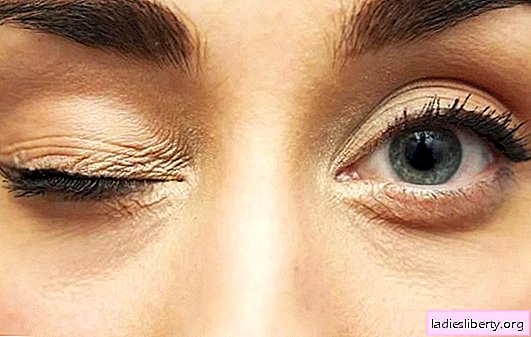
Many in their lives have been confronted with a sudden eye twitching. This is a short-term, fast-passing phenomenon. But in some cases, twitching of the eyelid becomes constant and increases with fatigue or stress.
The main causes and pathogenesis of eye twitching
An involuntary twitching of the muscles of the lower eyelid, which cannot be controlled by volitional force, is called a nervous tic - myokimia. This is a serious neurological problem. She may be:
primary, or acquired;
secondary - developed against the background of a nervous system disease or after an injury.
The reason why the eye twitches is the resulting pathological nerve impulse that causes muscle contraction. She is in constant work, over time, pain appears in this place. This happens after past traumatic brain injuries or infectious diseases.
Other reasons
In addition to the above, there are a number of reasons:
heredity - in such people, twitching of the eye can occur without exposure to stress or other external causes; this usually occurs in childhood and passes with age;
genetic diseases in which twitching of the eyelids is one of their symptoms (Bell's paralysis, Touretto's syndrome, Parkinson's disease);
prolonged stress, chronic overfatigue, combined with lack of sleep - the most common reason why the eye twitches in a healthy person;
weakened immunity - a condition after recent acute respiratory viral infections;
deficiency of certain vitamins and minerals that are involved in certain processes occurring in nerve cells: B vitamins, glycine, calcium, magnesium (the lack of the latter causes involuntary muscle spasm - the resulting myokimia is accompanied in these cases by involuntary twitching of the leg muscles; similar conditions can occur in the period of pregnancy, during sports competitions, when there are stress and physical exertion);
eye fatigue and dryness of the mucous membrane of the cornea of the eye: in this case, due to nerve impulses entering the brain, a protective reaction of the body occurs in the form of twitching of the eyelid - the eye becomes moisturized, occurs mainly in old age and in women in menopause;
the consequences of the use of certain medications - antidepressants and antiallergic;
previous strokes, injuries, infections (meningitis, encephalitis), intoxication, changes in intracranial pressure, existing brain tumors;
long work at the computer;
a big load on the eyes with their existing pathology and low visual acuity (if a person does not wear glasses or they do not fit him);
the use of caffeine and alcohol in large quantities:
the use of contact lenses without observing the necessary requirements;
allergic reactions: the circular muscle of the eye contracts from exposure to histamine released into the tear fluid.
A child's teak can develop from fright. But such conditions, as a rule, pass the next day. To speed up the process, a warm bath with soothing herbs and massage are recommended.
Main symptoms
The main symptom of myokimia is twitching of the upper or lower eyelids. The process is usually asymmetric: only one eye twitches. The process occurs spontaneously; a person cannot control it. A jerking begins suddenly. If there is no serious pathology, then everything ends as unexpectedly as it began. In the initial stages, everything happens unnoticed by others. But as the eye progresses, it twitches more often and more intensively. In the future, the second eye may be involved in the process. This disrupts the function of vision.
How to stop the pathological process
Despite the many reasons why the eye twitches, as well as different ways of developing a symptom, in certain cases when there is no organic damage, it is possible to recover from myokimia. The main method is to eliminate the negative factor that causes twitching of the eyelid:
1. Full relaxation and sleep. You must sleep at least 8 hours. "Sleeping" for the whole week-end weekend will not solve the sleep problem.
2. Limiting the time of work at the computer. If this is not possible, it is necessary to arrange breaks of 10 to 15 minutes every hour to reduce eye strain.
3. Reception of sedatives as natural (teas with mint, lemon balm, hawthorn, valerian, motherwort), and pharmacological preparations.
4. Physiotherapeutic treatment will help restore the normal state of the nervous system and get rid of twitching of the eyelids.
5. Restriction of drinks containing caffeine (coffee, black tea). They can be replaced with herbal teas, as an alternative to consume green tea (it contains caffeine in a bound form - ten, which reduces its tonic effect on the nervous system). The excitatory effect of coffee and tea is also reduced by adding milk to them.
6. Refusal of alcoholic beverages.
7. Inclusion in the diet of foods containing a lot of magnesium and B vitamins: chocolate, bananas, dried fruits, buckwheat, oatmeal, sunflower seeds, nuts, beans.
Stress relief
If the resulting twitching of the eye is a rare isolated case and has arisen in connection with severe stress, you need to try to remove it by doing a few physical exercises. In a relaxing way, the eye muscle will be affected by a light massage of the eye muscle closer to the place where it twitches.
In addition, there are several simple exercises that will help, in the absence of a serious pathology, to remove an unpleasant twitching of the eye: you need to hold your breath and tighten your eyes tightly, then take a deep breath and open them. Repeat the exercise 5 times. Also, a rapid intense blinking of eyes for 2 minutes has a positive effect. This gymnastics at the same time will be the prevention of the occurrence of a tick, if it has already been observed in the past.
Specialist treatment
Timely appeal to a neurologist and optometrist. These specialists will determine the reason why the eye twitches, and prescribe the necessary measures to eliminate and, if necessary, medications. It can be:
recommendations for using special glasses for the computer;
selection of glasses with low visual acuity;
special drops and gels to moisturize the mucous membranes of the eye;
possibly antihistamines in case of allergies;
a complex of vitamins and minerals.
Botox Introduction
In the case of a severe resistant tic, when the eye twitches constantly and with great intensity and causes not only discomfort, but also disrupts the visual process, causes pain, neuropathologists prescribe botulinum toxin-based drugs to the muscle, which is in constant contraction (Botox administration). But first, she will conduct an examination to exclude more serious causes that led to a tic: tumors, damage to the facial nerve, brain problems after injuries or diseases that were in the past.
Prevention
Thus, finding out why the eye twitches, it will be possible to balance your lifestyle on your own, which will be the first step in getting rid of this problem. The reason for this uncomfortable state does not always lie on the surface. Therefore, self-medication can only worsen the condition and adversely affect the general condition.
A twitching of the eyelid associated with a serious eye pathology requires treatment by an ophthalmologist. It will be necessary to undergo certain diagnostic tests, both laboratory and on special devices. Correction of treatment by a neurologist is also possible, which must be addressed at the first sign of a tick. If you do not postpone specialist consultations, you will be able to timely interrupt this unpleasant process and get rid of it forever.
At the first signs of twitching of the century, you need to minimize communication with people that cause a negative effect on emotions.
You need to try to avoid stressful situations, take care of your inner peace and set yourself up for positive things - this will be the key to health and self-confidence.











